 |
|
Biography
Dr. Mischa Thesberg is a Canadian researcher within the IuE. He has a B.Sc. (2008) in Computational Science from the University of Waterloo and an M.Sc. (2010) and Ph.D. (2014) in Computational Condensed Matter Physics from McMaster University. His research focuses on quantum transport and high-performance computing methods and his most recent interests include thermoelectrics, two-dimensional materials, novel nanoelectronics devices and quantum transport formalisms such as the Non-Equilibrium Green's Function (NEGF) approach.
Numerical Approaches in Quantum Transport and the Study of Renewable Energy Technologies
Our work in 2017 was focused on two main areas: 1) The continued development and extension of a quantum transport simulator for the study of nano-engineered devices; and 2) working with an industry partner to characterize and improve designs for a silicon/silicon-germanium quantum-well solar cell. In addition to these projects, work was also continued on the topic of nano-structured thermoelectrics for renewable energy applications.
When designing new semiconductor devices and materials with features approaching that of the nanometer, the key physics governing the flow of charge changes from the classical to the quantum mechanical. With this, the basic phenomenology, as well as fundamental description and governing equations, also change. Ongoing work within our group has focused both on how such quantum transport can be computationally modelled in an efficient way and how these models can be harnessed to assess the potential for improving the efficiency of thermoelectric materials. Our work on the development of new quantum transport simulation codes is being integrated into a commercially available product, which is marketed towards the semiconductor industry. This solver allows for the analysis of devices with irregular geometries and situations where transport physics is quantum mechanical but still dominated by scattering with phonons. In the course of developing such an algorithm, a number of new things have been learned about the behavior of the commonly used non-equilibrium Green's function formalism and its application to unstructured finite-volume meshes.
A final aspect of our work during the last year has been to assist a local start-up company via the characterization of experimental data and device simulation. This work has related to the development of new designs for a silicon solar cell augmented with silicon-germanium and silicon-carbide nano-features.

Fig. 1: The charge density and transmission function (bottom right) of a pinch junction as it is thinned.



